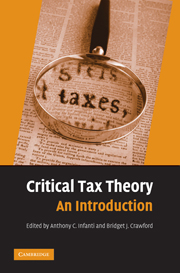Book contents
- Frontmatter
- Contents
- List of Illustrations
- List of Tables
- List of Contributors
- List of Common Abbreviations
- Introduction
- CHAPTER 1 FOUNDATIONS OF CRITICAL TAX THEORY
- CHAPTER 2 HISTORICAL PERSPECTIVES ON TAXATION
- CHAPTER 3 THE GOALS OF TAX POLICY
- CHAPTER 4 CRITICAL TAX THEORY MEETS PRACTICE
- CHAPTER 5 RACE AND TAXATION
- CHAPTER 6 GENDER AND TAXATION
- Not Color- or Gender-Neutral: New Tax Treatment of Employment Discrimination Damages
- Taxing Housework
- The Marital Deduction QTIP Provisions: Illogical and Degrading to Women
- A Taxing Woman: The Relationship of Feminist Scholarship to Tax
- CHAPTER 7 SEXUAL ORIENTATION AND TAXATION
- CHAPTER 8 THE FAMILY AND TAXATION
- CHAPTER 9 CLASS AND TAXATION
- CHAPTER 10 DISABILITY AND TAXATION
- CHAPTER 11 GLOBAL CRITICAL PERSPECTIVES ON TAXATION
- CHAPTER 12 CRITICAL PERSPECTIVES ON CRITICAL TAX THEORY
- Index
The Marital Deduction QTIP Provisions: Illogical and Degrading to Women
Published online by Cambridge University Press: 04 August 2010
- Frontmatter
- Contents
- List of Illustrations
- List of Tables
- List of Contributors
- List of Common Abbreviations
- Introduction
- CHAPTER 1 FOUNDATIONS OF CRITICAL TAX THEORY
- CHAPTER 2 HISTORICAL PERSPECTIVES ON TAXATION
- CHAPTER 3 THE GOALS OF TAX POLICY
- CHAPTER 4 CRITICAL TAX THEORY MEETS PRACTICE
- CHAPTER 5 RACE AND TAXATION
- CHAPTER 6 GENDER AND TAXATION
- Not Color- or Gender-Neutral: New Tax Treatment of Employment Discrimination Damages
- Taxing Housework
- The Marital Deduction QTIP Provisions: Illogical and Degrading to Women
- A Taxing Woman: The Relationship of Feminist Scholarship to Tax
- CHAPTER 7 SEXUAL ORIENTATION AND TAXATION
- CHAPTER 8 THE FAMILY AND TAXATION
- CHAPTER 9 CLASS AND TAXATION
- CHAPTER 10 DISABILITY AND TAXATION
- CHAPTER 11 GLOBAL CRITICAL PERSPECTIVES ON TAXATION
- CHAPTER 12 CRITICAL PERSPECTIVES ON CRITICAL TAX THEORY
- Index
Summary
In 1981, Congress enacted the qualified terminable interest provisions (QTIP) that allow an estate and gift tax marital deduction for the full value of the underlying property where a spouse receives only a qualifying income interest for life and where the executor of the estate or the donor spouse makes a timely election. Generally, however, the availability of the estate and gift tax marital deduction is restricted to the transfer of property ownership itself from one spouse to the other. Congress adopted the QTIP provisions as an extension of its contemporaneous decision to select the marital unit as the unit of taxation for estate and gift taxes. Congress believed that most couples view property acquired during the marriage as “ours.” Therefore, Congress reasoned that as long as the property is subject to transfer taxes when it leaves the marital unit it is not necessary that the surviving spouse own, or control the ownership of, the underlying property. However, the reality is that only one spouse (the donor spouse or decedent) controls the transfer of the underlying property. Making a QTIP election, including naming the ultimate beneficiary of the property, does not in fact require both spouses' participation. In the case of a gift, the donor alone makes that election; in the case of a testamentary transfer, the executor of the QTIP trust has that responsibility. In both cases, it is the transferor alone who determines the final recipient of the property, and in both instances it is a transfer to a nonspouse.
- Type
- Chapter
- Information
- Critical Tax TheoryAn Introduction, pp. 170 - 175Publisher: Cambridge University PressPrint publication year: 2009
- 1
- Cited by



